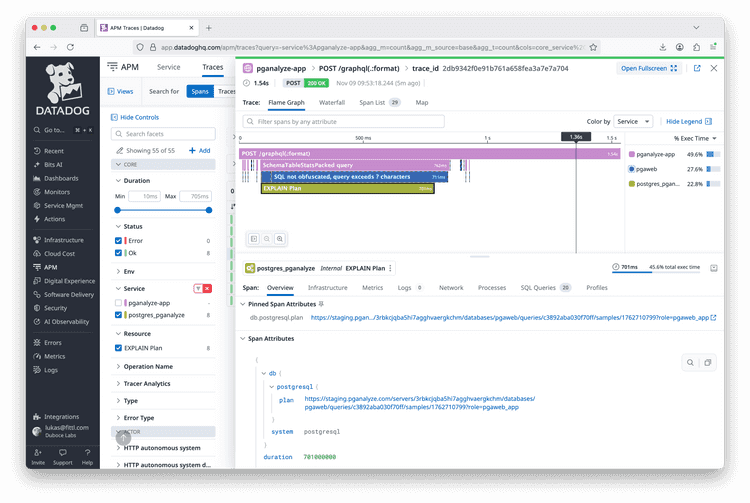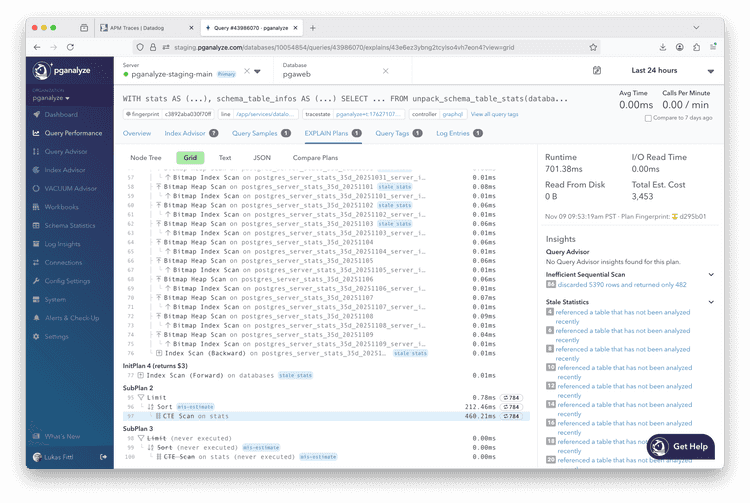Integrating pganalyze with Datadog APM
You can set up the pganalyze collector OpenTelemetry exporter with Datadog APM to show spans for slow query EXPLAIN plans inside your traces. The span contains the link to the EXPLAIN plan in the pganalyze app, so that you can easily visit the pganalyze page to find out why the query is slow.
Compared to Datadog DBM, pganalyze gives you exact details on the specific query execution
by combining auto_explain data extracted from the Postgres logs with a specific trace.
For example, in this specific request we can determine that the slowness originated in a Nested Loop that executed 784 times over a CTE scan:
Setup steps
- Annotate your queries with tracing information
- Set up the OpenTelemetry exporter to send to Datadog
- Configure pganalyze collector to send to the OpenTelemetry collector
Annotate your queries with tracing information
In order for query samples to be correlated with the original trace on the application side,
the special traceparent tag is utilized.
When you're using a Datadog tracing library in your application, set DD_DBM_PROPAGATION_MODE
to full. This setting affects what the library adds to queries, and does not require using Datadog DBM.
With full propagation, the library will automatically set traceparent as a query comment / query tag:
/* dde='dev',ddps='api',ddpv='1.2',dddbs='db_service',traceparent='00-00000000000000000000000000c0ffee-0000000000000bee-fe'*/
SELECT * FROM my_table;If you are not using the Datadog tracing library, for example when using OpenTelemetry SDKs, read the alternate documentation on how to add the traceparent query tag within your application.
Set up the OpenTelemetry exporter to send to Datadog
There are different mechanisms to send OpenTelemetry tracing data to Datadog. In this example
we are using the OpenTelemetry collector
with the datadog/exporter from the contrib collection.
Alternate mechanisms include the DDOT Collector (an OpenTelemetry collector distribution), or the Datadog Agent. Note that Datadog's direct OTLP ingest does not yet support tracing data.
First, we install the OpenTelemetry collector, as described in the OpenTelemetry documentation. We then configure the Datadog contrib modules, as described in the Datadog documentation.
In this case we installed the package on a VM, so we edit the otel collector configuration located in /etc/otelcol-contrib/config.yaml to export to Datadog.
receivers:
otlp:
protocols:
http:
endpoint: 0.0.0.0:4318
grpc:
endpoint: 0.0.0.0:4317
processors:
batch:
send_batch_max_size: 100
send_batch_size: 10
timeout: 10s
exporters:
datadog/exporter:
api:
site: datadoghq.com
key: REPLACE_WITH_DATADOG_API_KEY
debug:
service:
pipelines:
traces:
receivers: [otlp]
processors: [batch]
exporters: [datadog/exporter]We now restart the otel collector to use the new configuration:
systemctl restart otelcol-contribConfigure pganalyze collector to send to the OpenTelemetry collector
With the OpenTelemetry collector configured correctly, we now configure the pganalyze collector to emit trace data from slow query plan samples via OpenTelemetry. This requires internal network connectivity between the pganalyze collector and the OpenTelemetry collector.
On the pganalyze-collector configuration, set the otel_exporter_otlp_endpoint
(OTEL_EXPORTER_OTLP_ENDPOINT) variable to point to the internal OTLP endpoint on the
OpenTelemetery collector, for example:
# pganalyze-collector environment variables
OTEL_EXPORTER_OTLP_ENDPOINT=http://10.0.0.42:4318In this case 10.0.0.42 is the IP of the VM/container running the OpenTelemetry collector.
Optionally, you can also set otel_service_name (OTEL_SERVICE_NAME) to update
the service name reported to Datadog from the pganalyze collector. It defaults
to Postgres (pganalyze) which shows in Datadog as the postgres_pganalyze
service.
Make sure to restart the collector after updating the settings.
Couldn't find what you were looking for or want to talk about something specific?
Start a conversation with us →

